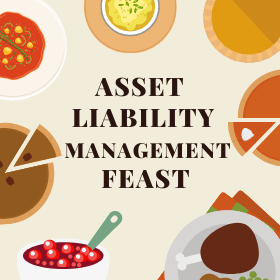By Maryssa Crews, Catalyst Strategic Solutions, ALM Analyst
 Asset liability management (ALM) can be somewhat daunting. You may be wondering, “What is the best way to allocate the balance sheet to minimize risk and optimize earnings?” To fully grasp ALM, you need an understanding of different types of risk and how the balance sheet composition affects those risk levels. Over time, ALM has evolved from a simple measure of asset and liability mismatch to a coordinated process that identifies, measures, manages, and monitors risk and its effects on capital and income.
Asset liability management (ALM) can be somewhat daunting. You may be wondering, “What is the best way to allocate the balance sheet to minimize risk and optimize earnings?” To fully grasp ALM, you need an understanding of different types of risk and how the balance sheet composition affects those risk levels. Over time, ALM has evolved from a simple measure of asset and liability mismatch to a coordinated process that identifies, measures, manages, and monitors risk and its effects on capital and income.
At its base, ALM is the process of structuring assets and liabilities to maintain sufficient future earnings and capital strength. Much like balancing flavors in a dish, ALM aims to balance risk and return. For a credit union to be profitable, typically it must take on some amount of risk. ALM reporting can be used for risk management and financial planning to provide solutions for problems associated with changing circumstances.
With the holiday season fast approaching, it may be helpful to compare risk assessment tools to a Thanksgiving feast. Your ALM report is the meat of your meal. Whether ham, turkey or even tofurky, it’s the main course. The ALM report focuses on interest rate risk but can also highlight inherent liquidity and credit risks. While there are no regulatory mandates describing how interest rate risk should be assessed at individual credit unions, there are specific recommendations within the Interagency Advisory on Interest Rate Risk Management. The advisory advocates for methods to measure interest rate risk over various time frames, as well as for running static versus dynamic balance sheets. The three main methods of assessing risk are the: 1) gap ratio analysis, 2) net interest income (NII) simulation, and 3) net economic value (NEV) analysis. Respectively, these measure asset and liability mismatch in the short term, risk to earnings in the intermediate term, and risk to equity in the long term. For each of these analyses, interest rate shocks are applied to see how capital and earnings move with the rates.
What is a holiday meal without the fixings? Mashed potatoes, cranberry sauce and green bean casserole! They don’t have to be at the dinner, but they sure enhance the experience. There are solutions available that complement the standard ALM report. These include a non-maturity deposit analysis to more accurately model a credit union’s specific deposit behavior, the liquidity stress test to identify liquidity shortfalls across several different scenarios, and the mortgage servicing rights analysis to determine the fair value of servicing rights while assessing any weaknesses. While these analyses are not required, they help deepen the insights provided by the main report.
Finally, for dessert, run a what-if analysis. Holiday desserts can range from easier recipes, like cookies or pumpkin pie, to more labor intensive treats, such as sweet potato cheesecake or an apple tart. Similarly, a what-if analysis can encompass simple changes to assets, liabilities, and coupon rates to more intricate, strategic decisions concerning prepayments or non-maturity betas. Have a serving (or two!) of a what-if analysis to further your knowledge of how balance sheet allocation affects your risk levels.
Like a large holiday dinner, ALM may at first appear to be a full plate. But it’s an important tool for strategic planning, and different report sets highlight distinct aspects of balance sheet risk. My advice? Take your time with each course and enjoy the meal!
To further complement your Thanksgiving feast, Catalyst Strategic Solutions’ “well-seasoned” ALM and Advisory Teams offer a comprehensive suite of balance sheet services. For information, contact us today!